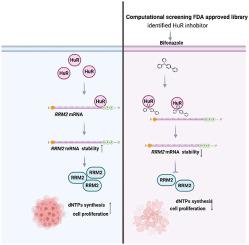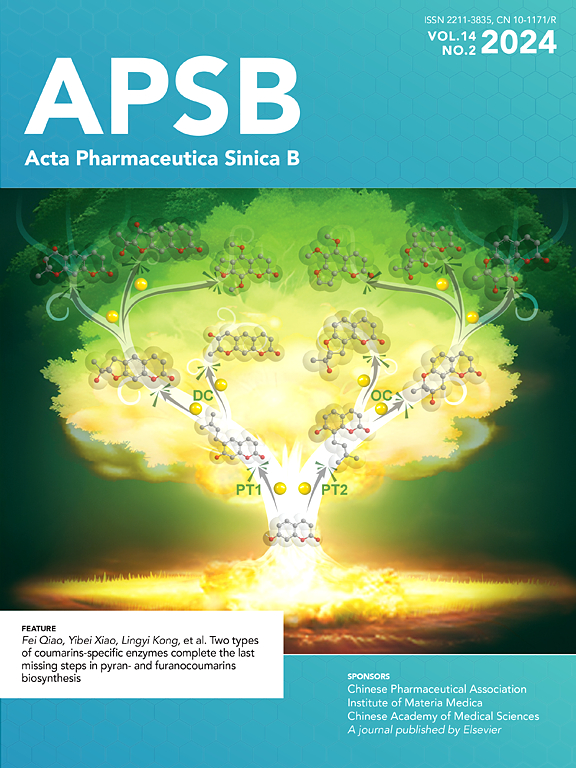核糖核苷酸还原酶小亚基 M2 通过 HuR 介导的 mRNA 稳定促进食管鳞状细胞癌细胞增殖
IF 14.7
1区 医学
Q1 PHARMACOLOGY & PHARMACY
引用次数: 0
摘要
食管鳞状细胞癌(ESCC)是一种消化系统恶性肿瘤,由于缺乏早期诊断生物标志物和有效的治疗靶点,其发病率很高,是全球癌症相关死亡的主要原因。核糖核苷酸还原酶(RNR)表达失调已被证实与肿瘤发生有因果关系。本研究表明,核糖核苷酸还原酶小亚基M2(RRM2)在ESCC组织中显著上调,其表达与临床预后呈负相关。从机理上讲,HuR通过与3′UTR内富含腺嘌呤/尿苷元素(AU)结合促进mRNA稳定,从而导致RRM2持续过表达。此外,通过计算筛选和分子对接分析,确定联苯苄唑是 HuR 的抑制剂。联苯苄唑通过在 F65、R97、I103 和 R153 残基与 HuR 竞争性结合,破坏了 HuR 与ARE 的相互作用,导致 RRM2 表达量减少。此外,联苯苄唑通过降低 RRM2 的表达和 dNTP 池,对 ESCC 患者衍生异种移植(PDX)模型产生抗肿瘤作用。总之,本研究揭示了 HuR、RRM2 和联苯苄唑之间的相互作用网络,并证明联苯苄唑是一种通过抑制 HuR/RRM2 轴治疗 ESCC 的潜在化合物。本文章由计算机程序翻译,如有差异,请以英文原文为准。

Ribonucleotide reductase small subunit M2 promotes the proliferation of esophageal squamous cell carcinoma cells via HuR-mediated mRNA stabilization
Esophageal squamous cell carcinoma (ESCC), a malignancy of the digestive system, is highly prevalent and the primary cause of cancer-related deaths worldwide due to the lack of early diagnostic biomarkers and effective therapeutic targets. Dysregulated ribonucleotide reductase (RNR) expression has been confirmed to be causally linked to tumorigenesis. This study demonstrated that ribonucleotide reductase small subunit M2 (RRM2) is significantly upregulated in ESCC tissue and that its expression is negatively correlated with clinical outcomes. Mechanistically, HuR promotes RRM2 mRNA stabilization by binding to the adenine/uridine (AU)-rich elements (AREs) within the 3′UTR, resulting in persistent overexpression of RRM2. Furthermore, bifonazole is identified as an inhibitor of HuR via computational screening and molecular docking analysis. Bifonazole disrupts HuR-ARE interactions by competitively binding to HuR at F65, R97, I103, and R153 residues, resulting in reduced RRM2 expression. Furthermore, bifonazole exhibited antitumor effects on ESCC patient-derived xenograft (PDX) models by decreasing RRM2 expression and the dNTP pool. In summary, this study reveals the interaction network among HuR, RRM2, and bifonazole and demonstrated that bifonazole is a potential therapeutic compound for ESCC through inhibition of the HuR/RRM2 axis.
求助全文
通过发布文献求助,成功后即可免费获取论文全文。
去求助
来源期刊

Acta Pharmaceutica Sinica. B
Pharmacology, Toxicology and Pharmaceutics-General Pharmacology, Toxicology and Pharmaceutics
CiteScore
22.40
自引率
5.50%
发文量
1051
审稿时长
19 weeks
期刊介绍:
The Journal of the Institute of Materia Medica, Chinese Academy of Medical Sciences, and the Chinese Pharmaceutical Association oversees the peer review process for Acta Pharmaceutica Sinica. B (APSB).
Published monthly in English, APSB is dedicated to disseminating significant original research articles, rapid communications, and high-quality reviews that highlight recent advances across various pharmaceutical sciences domains. These encompass pharmacology, pharmaceutics, medicinal chemistry, natural products, pharmacognosy, pharmaceutical analysis, and pharmacokinetics.
A part of the Acta Pharmaceutica Sinica series, established in 1953 and indexed in prominent databases like Chemical Abstracts, Index Medicus, SciFinder Scholar, Biological Abstracts, International Pharmaceutical Abstracts, Cambridge Scientific Abstracts, and Current Bibliography on Science and Technology, APSB is sponsored by the Institute of Materia Medica, Chinese Academy of Medical Sciences, and the Chinese Pharmaceutical Association. Its production and hosting are facilitated by Elsevier B.V. This collaborative effort ensures APSB's commitment to delivering valuable contributions to the pharmaceutical sciences community.
 求助内容:
求助内容: 应助结果提醒方式:
应助结果提醒方式:


